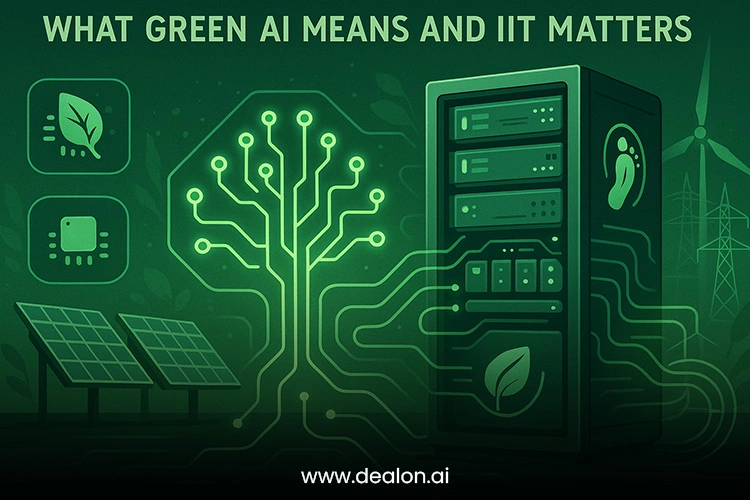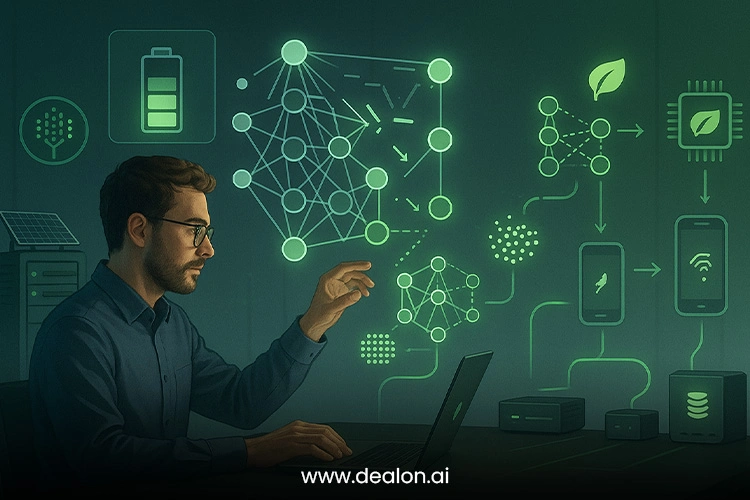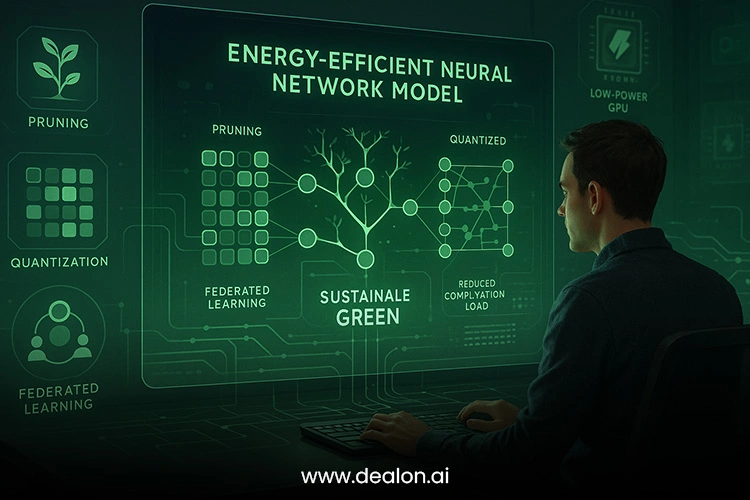The advancements in AI in the years gone by have been phenomenal and have evolved with the remarkable ability to solve complex problems and transform business operations and everyday lives. With new technologies, certain obstacles remain, such as the environmental impact.Creating and training modern machine learning models requires training with large data sets and complex algorithms, which require a lot of energy to compute and result in a large carbon footprint. The demographic shift does raise an important question: as AI widens its applications, what is the extent of its impact? ‘Green AI’ attempts to resolve such issues of energy efficiency and focuses on sustainability within AI to shift the paradigm.
Green AI focuses on the construction, training, and deployment of AI models to enable maximum performance with minimal environmental footprints. This is achieved through energy-efficient training of machine learning models, optimized hardware, data centers powered through renewable sources, and the promotion of resource-efficient computational algorithms. Although AI is used in a variety of applications, such as healthcare and transportation, the need for Green AI is of utmost importance and relevance.
The promise of Green AI exceeds simply being eco-friendly; it is an opportunity to fundamentally change how AI is created and how it is used, and fuse together technological progress with caring for the environment. From using low-power processors to applying transfer learning and federated learning, Green AI is rich in diverse strategies for constructing AI systems more sustainably.
As the global community moves to a Green Economy, we must ensure that AI progresses to become more than simply a means for progress but a partner in addressing climate change. This blog looks at the emergence of Green AI, with an emphasis on providing actionable, powerful, and eco-friendly sustainable machine learning models.
Also Read: AI and Human Emotions: Can Machines Truly Understand What We Feel?
What Does Green AI Mean, and Why Is It Important?

The development and deployment of AI technologies comprising a Green AI approach is the practice of constructing and using Artificial Intelligence systems with an emphasis on their pollution-minimizing features. The use of computational energy for training, and the energy used for inference in AI models, in particular deep learning, has negative external energy consequences. The conventional approach to training an AI uses the data to go through a couple of thousand GPUs for a prolonged time, and this is during the training stage, not counting the inference stage.
Green AI addresses this issue by enhancing the computational efficiency of machine learning algorithms to minimize the environmental cost of AI development. Instead of performance reduction, Green AI aims to reduce the energy spent during the training phase and the deployment phase. Use of energy-efficient hardware, model compression, and data pruning strategies will create AI systems that are intelligent and energy-conscious. Green AI also understood the need to include sustainable approaches in hardware architecture; data center constructions that use renewable energy resources, and AI systems that are responsible for the use of the hardware resources.
The Need for Green AI Systems

The AI footprint on the environment is significant, especially in the context of the training of large-scale models. One of the latest models in the market can use more electricity than the average home consumes in five years. Training the model GPT-3-3 3 for instance, is estimated to possess a carbon footprint of multiple cars over its lifetime. This is indeed alarming. As more and more people adopt this technology and advanced AI systems, the environmental footprint is also expected to grow, and this is why a strategy to sustain the system is highly required.
The energy-intensive nature of AI rests on colossal data processing needs, predominantly drawing on fossil fuel-based energy. The augmented energies of AI rest upon a bounded level of data processing, which requires electricity predominantly derived from fossil fuels. The huge dependence on non-renewable sources of energy has been a dominant cause of greenhouse gas emissions.
At least, however, members within the “AI” community have begun attempts at mitigating the consequences of the above emissions. As such, Sustainable AI, or “Green AI,” focuses on these attempts but attempts a revolutionary paradigm shift by endorsing the continuous growth of the field while utilizing the rationalized and already available, optimally configured computing systems of modern AI.
Examples of “Green AI” include energy-efficient algorithms, the optimization of hardware for data processing, and the design of new cooling systems for data centers, which were the first steps taken to integrate AI into already overburdened infrastructures harmoniously.
The immense potential for reducing energy expenditure in AI-based federated learning, which, in its advanced form, most of the processing occurs locally, with only the results sent to a central server, is a paradigm shift. In addition to the recent advances in AI-powered methodologies, the growing investments in renewable energy have been a key driver towards making the carbon sink paradigm resilient and sustainable.
Focused Approaches for Constructing ML Models that Ensure Sustainability

It is already well understood that creating AI models that are environmentally sustainable requires no less than a strategic approach because of the rapid increase in computational power needed. While AI tools are continuously changing the world in various domains, their training and the power required for that are equally worth reviewing from an environmental perspective. Practices geared toward machine learning sustainability tend to focus on practices that cut down the massive Qi energy consumption and carbon footprint across the board, designed for AI development. Listed below are sustainable practices for building AI systems that have been proven.
Clever Model Design and Structure
The model structures themselves are one of the levers available for engineers to use to directly decrease the burdens machine learning systems place on their environments. In the world of deep learning, models are known to be one of the most empowering tools available to users, and, at the same time, one of the most computationally resource-heavy, therefore quite burdensome to the environment. With a decrease in resource outlay on the training, deep learning, and inference systems, energy consumption is thus minimized.
Techniques like model pruning and quantization represent the leading edge of optimizing model architecture. Model pruning involves removing unnecessary parameters or weights from a neural network to lessen its size and complexity while maintaining its performance. Even complex neural networks can be much more lightweight and faster if unnecessary redundant components are removed. In addition, the total number of parameters of the model is redundant and thus, reduces in direct correlation with the neural network’s total computation resources and therefore, the overall energy consumed.
Quantization is another essential technique, which involves reducing the precision used in the model’s operations. Rather than working with more precise floating point numbers, quantization uses lower precision types and thus, more compact models with faster than lower complex computation speeds. With quantization in the model as a design parameter, the total number of bits consumed for an efficient representation of the neural network is significantly lower, which translates to more efficient energy use. Together, these methods lower the total computation burden to help AI developers improve their performance with a lower impact on the environment.
Optimizing the training algorithms and the data
Training machine learning systems is a multi-faceted and complicated problem. The more machine learning systems come into being, the more complex and robust methods are being created to train them. The data to train machine learning systems is expensive, and the systems amplify the cost with the cost of training.
Choosing the data to train machine learning systems optimally is a research question. Suppose a data set has a lot of redundant and irrelevant data; it’s more likely to cost the system more. A smaller data set is more likely to be noise-free than a large data set. The curated data set cut down the extensive data set by sacrificing little data.
The less redundant data there is, the less the system has to work. The set that is more devoid of irrelevant data is less likely to be noise. Noise in the data set is expected to enhance the burden of the system. Data that is noise-free is a liberating set to work with. Having less data to train a machine learning system in a lesser amount of time means it’s free from the burden on the environment.
Optimizing algorithms for learning models helps in minimizing energy usage. Less complex algorithms require less energy. An example is federated learning, in which models train on several decentralized devices without shifting huge files onto a server. This approach lessens the energy spent on transmission and places less demand on the servers. The result is a more eco-friendly approach to learning.
Harnessing renewable energy is the next step for progress.
AI-heavy infrastructures require data centers and energy. In a bid to ease the drastic effects of developing AI, more firms utilize renewable energy to power their data centers. Google and Microsoft set an example for other firms by shifting their data centers to 100% renewable energy in a bid to lower their carbon footprint. This significantly reduces the overall carbon emissions from the company.
Moreover, creators of AI technology can use green cloud computing services. Different companies have pledged to use renewable energy data center infrastructure, which allows companies to run AI models on green computing and significantly reduce their environmental footprint. Developers who run AI workloads on renewable cloud servers can guarantee that their models are powered by green energy and are practicing the tenets of Green AI.
Model Reusability and Transfer Learning
One of the strategies that can lead to the increased sustainability of AI systems is transfer learning. Transfer learning tickets for the use of pre-trained models for new tasks, which has been shown to significantly lessen the amount of computing resources needed for model development. A model is more likely to be implemented if a portion of it can be reused. A developer can improve a model’s performance on a new task with minimal additional energy expenditure if that model has already been trained for specific applications.
By reusing existing models, developers can extend their lifecycle and avoid the environmental cost of constant retraining, as transfer learning helps save energy during the training phase and extends the longevity of the AI systems. This strategy helps reduce the need for training as well as new models, increasing the time and resource efficiency of the AI systems.
Strategies for Efficient Selection of Ecological Hardware
The machine learning models’ training is done on a given set of hardware, which has paramount significance in how the given set of models conserves energy. AI systems, and more specifically, deep learning systems, require advanced computational systems that can handle the most demanding and complex computations with the least energy. Therefore, the decision to switch to energy-efficient systems is paramount to lowering the global warming potential of the AI systems.
The energy-efficient chip systems are in their class, in that they are purposely made for high output and low energy-consuming systems, as opposed to the traditional GPUs that require high power for the given set of processes. Hence, a sizeable reduction in the power usage and subsequent diminishment of the deep learning systems’ power and environmental cost is realized.
Another positive strategy to obtain sustainable artificial intelligence is edge computing—keep data at its immediate source rather than sending it to a server situated at a central point. Edge computing eliminates the need for massive geospatial data transfers, which saves both energy and bandwidth by lowering the need for centralized data processing. This further allows AI models to function without the burden of data-hungry center dependence, aiding in a sustainable, clean future for AI.
The Future of Green AI: A Sustainable Path Forward
The sweeping importance of AI is its application in solving various geopolitical complexities, which is why its integration with sustainability aspects in its design is paramount. AI has massive potential in solving even the most dire and fundamental challenges, like climate change, medicine, and education.
So, with further advancing technologies, the ecological footprint of the planet suffers at the forefront due to the undue large-scale energy expenses, carbon emissions, and training costs of AI. This is where branching to Green AI is advantageous, as AI slowly integrates and expands across the globe, it will promise to keep the planet at the center of its advancement.
For example, being able to keep the energy-efficient algorithms and manage the data processing overheads to a minimum should lower the energy demands needed during the execution of machine learning models, while still achieving equal or even improved outcomes. In the future, Green AI is predicted to become a significant component of both the multidisciplinary domain and the commercial aspect of the field. As developers, engineers, and organizations become more aware of the environmental consequences of AI, the industry will begin to ease up on its unsustainable practices.
Further developments within the field of AI hardware, such as low-power chips and energy-efficient GPUs, will continue to be major facilitators of increased performance within AI systems. It is clear that the future of Green AI is promising, given the possibility of sustainable technologies amalgamating with the endless potential that AI offers; the core of this possibility lies with the potential for innovation to be coupled with environmentally sustainable practices during the development phase of the technology. These intertwining factors will set the mark for the new era of AI.
Conclusion
The practices of Green AI help to obscure the otherwise glaring mismatch between technological acceleration and the need to protect the environment. The principle of sustainability must underpin AI development. It is possible to rein in the environmental consequences of AI by strategically designing the models to be computationally efficient, powered by renewable energy sources, and coupled with judiciously selected hardware.
It is possible to envisage a scenario in which the principles of Green AI are as widespread as traditional AI. At this moment in time, such usage will ensure that the planet will be preserved for future generations. This augurs well for the paradigm shift to which AI will be contributing.

